I sure would like to know what is meant by "swords" in the context of the cover article. "Phaeton" was another head-scratcher, but it was a whole lot
easier to look up. After rereading the passage a few times I think I have an idea, but, of course, there's always room for doubt.
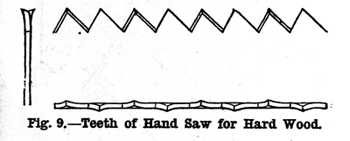
Such is the problem with technical verbiage. Comprehension is so experiential that even I get tripped up, and I'm an egregious offender. Confined to the shop, I routinely get away with using a lot of jargon. Consequently, it's hell when I visit the pub. If I had a dime for every time I got "Tim, I don't know what you just said," I'd be eating dime soup.
The worst part is I don't even realize I'm laying it on so thick. It all seems like common sense to me; one turns bowls with a gouge, one chops mortises, the alpha ferrite lattice is body-centered cubic until it reaches a critical temperature and becomes face-centered cubic austenite. It's the natural order of things.
It's frustrating as hell, but it's all my fault. I make the assumption that everybody over the age of 14 knows that "turn" in this context means, "revolve on a lathe against a cutting tool." I make the assumption that when I say "ripping," the person I talk to knows I'm using a saw to cut in a direction parallel to the run of the grain.
ARTICLES FOUND IN THIS ISSUE:
PIT-FRAME FOR WHEEL MAKING
•
SMITH'S WORK (CONT'D)
•
THE SAW: HOW TO USE IT (CONT'D)
•
THE TENANT'S GREENHOUSE (CONT'D)
•
WROUGHT IRON AND STEEL GIRDER WORK (CONT'D)
•
THE PREPARATION OF PLATING SOLUTIONS
•
SOME RATIONAL BOOKSHELVES
•
"LINING UP" (CONT'D)
•
OUR GUIDE TO GOOD THINGS
•
SHOP: A CORNER FOR THOSE WHO WANT TO TALK IT
< 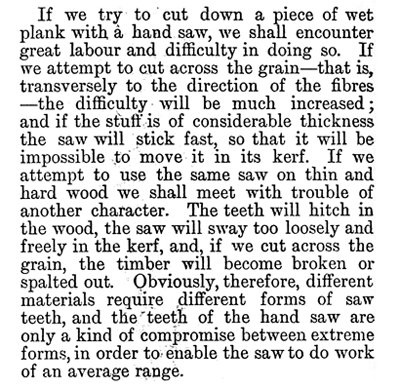
Well obviously. Right? Who's with me?
I pulled this quote specifically because It wasn't telling me anything new. I'd venture to guess a lot of the workateers out there have a decent grip on the theory of handsaws as well.
Stripped of the novelty of an unfamiliar subject, we can focus, instead, on how masterfully it encapsulates a vital fact while keeping jargon to a minimum. I might be completely familiar with this concept physically, but now my understanding has a verbal component suitable for evangelizing the masses.
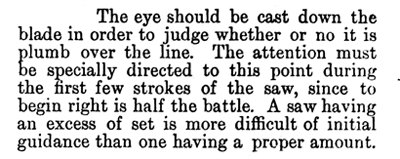
Do you see where I'm going with this? The writing in
Work can be an invaluable tool; not just for beginners and amateurs learning about a craft for the first time, but to seasoned veterans with a lot to teach.
Thinking about
Work in this way means all of the sections on basic skills actually pull double duty. The article in question is ostensibly handsaws 101 for n00bs and neophytes, but it's also a master-level class in talking about complicated mechanical relationships.
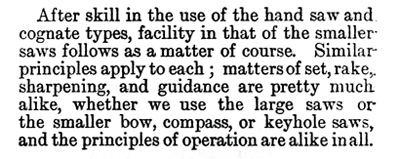 Roy Underhill and Chris Schwarz
Roy Underhill and Chris Schwarz are top-notch presenters because of the way they talk about their chosen subjects. Without patronizing, they introduce new concepts to the inquisitive but uninitiated. Technical terms are handled as carefully as sharpened tools. Knowing a lot about tools and techniques is great and all, but Chris and Roy use language to bring people into the fold.
So at the risk of sounding
preachy, we need to be more like them.
Work can provide a helpful model. Common knowledge is only common if everyone is talking about it. Put a little more urgently: if you try to be a practitioner of the manual arts, but you bail on the language component, be prepared for nobody to follow in your footsteps.
Anyway, I highlighted what I believe to be the "swords" in the diagram of the wheelwright's pit-frame. Someone could tell me I'm wrong. I originally thought they were the pieces of wood in figures 2 and 2A. As it happens, those are, astonishingly enough, "holdfasts."
–TIM
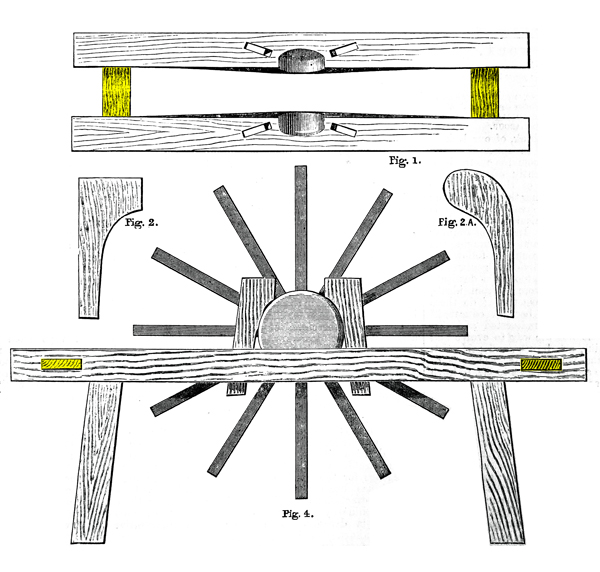
Click to Download Vol.1 - No. 15 •
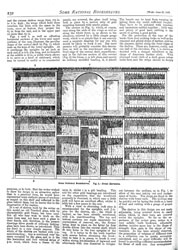
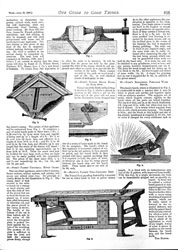
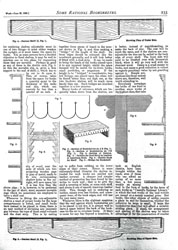
Disclaimer: Articles in Work: The Illustrated Weekly Journal for Mechanics describe materials and methods that would not be considered safe or advisable today. We are not responsible for the content of these magazines, and cannot take any responsibility for anyone attempting projects or procedures described therein.
The first issue of Work was published on March 23rd, 1889. The goal of this project is to release digital copies of the individual issues starting on the same date in 2012, effectively republishing the materials 123 years to the day from their original release.
The original printing was on thin, inexpensive paper. There are many cases of uneven inking and bleed-through from the page behind. Our copies of Work come from bound library volumes of these issues and are subject to unfavorable trimming, missing covers, etc. To minimize harm to these fragile volumes, we've undertaken the task of scanning the books ourselves. We do considerable post processing of the scans to make them clear but please bear with us if a margin is clipped too close, or a few words are unreadable. We would like to thank James Vasile and Karl Fogel for their help in supplying us with a book scanner and generally enabling this project to get off the ground.
You are welcome to download, print, and pretty much do what you want with the scan for your own personal purposes. Feel free to post a link or a copy on your blog or website. All we ask is a link back to the original project and this blog. We are not answering requests for commercial downloads or reprinting at this time.
 Joel's Blog
Joel's Blog Built-It Blog
Built-It Blog Video Roundup
Video Roundup Classes & Events
Classes & Events Work Magazine
Work Magazine


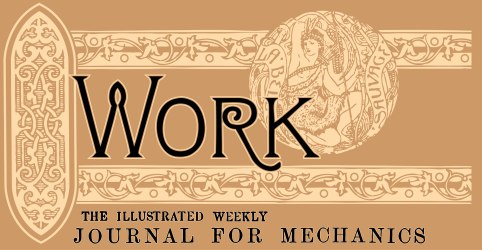
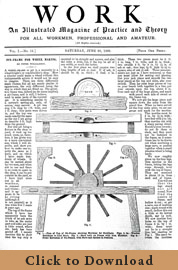
 Such is the problem with technical verbiage. Comprehension is so experiential that even I get tripped up, and I'm an egregious offender. Confined to the shop, I routinely get away with using a lot of jargon. Consequently, it's hell when I visit the pub. If I had a dime for every time I got "Tim, I don't know what you just said," I'd be eating dime soup.
Such is the problem with technical verbiage. Comprehension is so experiential that even I get tripped up, and I'm an egregious offender. Confined to the shop, I routinely get away with using a lot of jargon. Consequently, it's hell when I visit the pub. If I had a dime for every time I got "Tim, I don't know what you just said," I'd be eating dime soup. 
 Do you see where I'm going with this? The writing in Work can be an invaluable tool; not just for beginners and amateurs learning about a craft for the first time, but to seasoned veterans with a lot to teach.
Do you see where I'm going with this? The writing in Work can be an invaluable tool; not just for beginners and amateurs learning about a craft for the first time, but to seasoned veterans with a lot to teach. 



